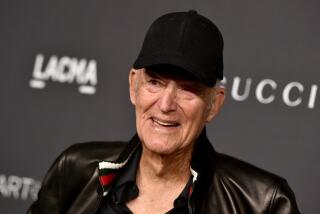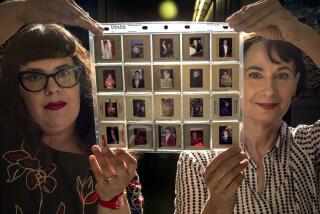Charles Passela; Photos Illuminated Museum Art
- Share via
Charles Passela, an innovative photographer who helped bring fragile illuminated manuscripts and other unique art treasures to the world through transparencies that provided detail for exhibits and scores of art books, has died. He was 68.
Passela, since 1987 the head of photographic services at the J. Paul Getty Museum, died Jan. 10 in Santa Monica Hospital of complications of a bone marrow disease, Getty officials announced.
Previously a consultant, Passela helped the Getty design and staff its photo facilities and photograph its vast and growing collection to publicize the new Getty Center around the world. His photos also illustrate such publications as “The J. Paul Getty Museum Handbook of the Collections” and “The J. Paul Getty Museum and Its Collections.”
Passela photographed the Getty’s treasures for about 20 art books, including “Masterpieces of the J. Paul Getty Museum: Illuminated Manuscripts” in 1997 and “Mira Calligraphiae Monumenta,” a 16th century calligraphic manuscript inscribed by Georg Bocskay and illuminated by Joris Hoefnagel” in 1992. He also oversaw photography for the Getty’s worldwide art conservation and preservation projects.
The photographer worked throughout his career to provide greater accessibility to medieval books that may have taken a monk nine years to create but could be damaged irreparably if even a handful of viewers leafed through the one-of-a-kind pages.
As head of photographic services for New York’s Pierpont Morgan Library from 1965 to 1983, Passela developed a system for carefully photographing pages in the 6- to 8-century-old books. His slides were then displayed along with a protectively encased book so that visitors could study the work’s contents without damaging the irreplaceable original.
John Plummer, retired curator of medieval and Renaissance manuscripts for the library, credited Passela with creating the exhibit system that made the institution famous in art circles. Over the decades, Plummer estimated, Passela “photographed more of the important manuscripts in this country than any other photographer.”
Passela’s photographs were published in exhibit materials and books cataloging the collections of various museums, including the Huntington Library in San Marino, New York’s Metropolitan Museum of Art and London’s British Museum and Victoria and Albert Museum.
Because his photographs were such a boon to the Pierpont Morgan Library, the institution began crediting him in its publications, the first time an art photographer had received such recognition.
In 1976, Passela earned the Carey-Thomas Award for Excellence in Publishing for his book titled “Early Children’s Books and Their Illustrations.”
During his work with the Pierpont Morgan Library and the Getty, Passela carried out other photographic projects, providing cover photos for such magazines as Apollo and Smithsonian, and contributing photos to Art in America, Connoisseur, Life, National Geographic, Newsweek, Time and the New Yorker. In 1983, he turned a portrait of Nathaniel Hawthorne into a stamp for the U.S. Postal Service.
Passela began his career as a top-secret Marine Corps aerial photographer who shot 16-millimeter training films for all branches of the armed services.
From 1954 to 1963, he photographed for Fawcett Publications in New York. He then worked as a commercial color printer and a commercial photographer specializing in still-life food photos until he joined the Pierpont.
Getty officials said Passela had no survivors.
More to Read
The biggest entertainment stories
Get our big stories about Hollywood, film, television, music, arts, culture and more right in your inbox as soon as they publish.
You may occasionally receive promotional content from the Los Angeles Times.










